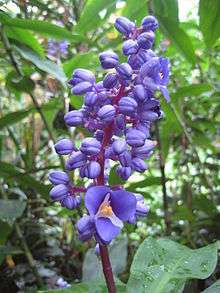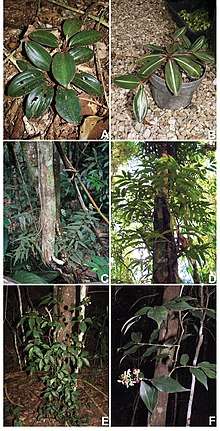Dichorisandrinae
Dichorisandrinae is a subtribe within the tribe Tradescantieae of the flowering plant family Commelinaceae. It consists of 5 genera and around 51 species.
| Dichorisandrinae | |
|---|---|
 | |
| Dichorisandra thyrsiflora | |
| Scientific classification | |
| Kingdom: | Plantae |
| Clade: | Tracheophytes |
| Clade: | Angiosperms |
| Clade: | Monocots |
| Clade: | Commelinids |
| Order: | Commelinales |
| Family: | Commelinaceae |
| Subfamily: | Commelinoideae |
| Tribe: | Tradescantieae |
| Subtribe: | Dichorisandrinae Faden & D.R.Hunt |
The subtribe represents a diverse assemblage native to tropical South America and a contiguous portion of Central America.[1] Not only is this subtribe remarkable for the range of morphological and ecological variation within it, but it also includes species that represent novel exceptions to the terrestrial habit, longitudinally-dehiscent anthers, and/or exarillate seeds typical of the family. Exceptional taxa include Dichorisandra, characterized by the unusual combination of a vining habit, poricidal anthers, and arillate seeds. Cochliostema is atypical in having an epiphytic habit and flowers with spirally-coiled anthers concealed in petaloid extensions of the filament. Geogenanthus is distinguished by a particular 6-celled stomatal complex and basal axillary inflorescences. Plowmanianthus consists of prostrate herbs shallowly rooted in the leaf-litter layer of rainforest floors, and the flowers of most Plowmanianthus species are primarily cleistogamous.[2]
Genera

Faden & Hunt's (1991) formal circumscription of the subtribe[1] did not include Plowmanianthus, which was then undescribed and poorly understood; Hardy & Faden added Plowmanianthus in 2004.[2] Members are perennial, primarily understory, herbaceous taxa united on the basis of chromosome morphology (generally large), a shared base chromosome number (x = 19), and a biseriate arrangement of seeds in each locule (two longitudinal files of seeds in each locule), although the seeds are uniseriate in Plowmanianthus.[2]
- Cochliostema Lem. – 2 species
- Dichorisandra Mik. – ca. 40 species
- Geogenanthus Ule – 3 species
- Plowmanianthus Faden & C.R.Hardy – 5 species
- Siderasis Raf. – 1 species
References
- Robert B. Faden & D. R. Hunt (1991). "The classification of the Commelinaceae". Taxon. 40 (1): 19–31. JSTOR 1222918.
- C. R. Hardy & Robert B. Faden (2004). "Plowmanianthus, a new genus of Commelinaceae with five new species from tropical America". Systematic Botany. 29 (2): 316–333. doi:10.1600/036364404774195511.